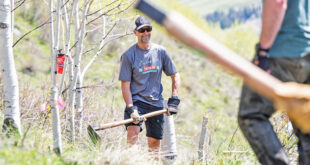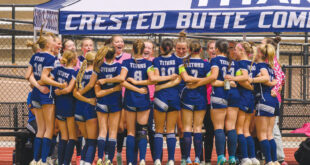“It’s like a room full of cobras and you just gotta Baryshnikov your way through”
“Expert kayakers find the Gunnison River through the National Park an arduous challenge. This stretch of the Gunnison is for only the most experienced and well equipped kayakers.”
—National Park Service introduction to kayaking the Black Canyon
Self-described “never has been” Milo Wynne just completed his 50th descent of the Black Canyon in a kayak. Or, as he puts it, “Local gray hair sticks with it, plucks 50 runs.”
According to Wynne, no one has done it 20 times, let alone 50. Furthermore, Wynne finished his 50th run well ahead of schedule. The plan was to paddle his 50th on his 50th birthday.
“I’m only 48 so I’m two years ahead of schedule,” says Wynne. “I’ll admit, I’m a little obsessive-compulsive on the Black. It’s just a fantastic place that gives you that special feeling. I don’t go in there because it’s dangerous—it’s beautiful. It just happens to be dangerous. It was a nerve-wracking 50.”
Wynne started paddling in 1991 and made his first descent of the Black Canyon in 1993-1994. He’s been to the far reaches of the globe to paddle rivers in Europe and Central America and through the deepest gorges in South America, but the Black keeps bringing him back.
“I’ve paddled stuff harder, but never something that dangerous,” says Wynne. “The Black Canyon is in a league of its own.”
The section is 16 miles long but starts well before the first paddle stroke as access to the put-in is via the East Portal Road, a seven-mile stretch with a pitch of 16 percent, rife with switchbacks.
“You want a vehicle with good brakes,” says Wynne. “The runaway truck ramp takes you into a cliff face to stop you.”
Make it there, and then the real fun begins.
“The rapids within the national park are considered Class V and some sections are unrunnable. This is a very technical paddle and includes numerous long, difficult and dangerous portages.”
—National Park Service description of the section of river
“It’s Class V, VI and rated X,” says Wynne.
Due to the deep chasm walls and rock-fall, the water has numerous hidden dangers that only become apparent at the worst possible times. Furthermore, the river’s dynamics change with the river’s level. Paddle strokes must be subtle but deliberate where the difference between a clean run through certain sections and carnage is a matter of centimeters.
“It’s like a room full of cobras and you just gotta Baryshnikov your way through,” says Wynne. “The deal with the Black is that water is going to mysterious places. We only skim the top six inches.”
Wynne recalls one trip where a kayaker swam and got sucked under into one of those “mysterious places.” When he finally came back up, his fingers and toes were raw, missing fingernails and toenails from clawing at the rock underneath trying to resurface.
“I’ve never seen anyone drown, but I’ve seen a lot of near-drownings,” says Wynne.
He describes several spots where you look down at the water and it’s just bubbling up from deep in the canyon like a hot tub.
“There are places where the river disappears,” says Wynne.
One such spot is the notorious mile-long portage known as the Hell Portage, yet another feature that makes running the Black Canyon once, let alone 50 times, “unique.” Paddlers must carry their boats up, over, around and through bus-size rocks and thick vegetation with no true discernable trail to follow.
“It’s basically the worst portage in the lower 48,” says Wynne. “There’s rock-fall, ticks and poison ivy over the head. I’ve seen it destroy the biggest and baddest motherf***ers on the planet.”
The portage alone can take up to three hours, although, with years of experience, Wynne can make it happen in under an hour.
In fact, due to the physical and mental demands of this stretch of river in the Black Canyon from East Portal to the Chukar Trail, it is recommended as a two-day run. Wynne makes it a one-day trip with his fastest run to date four and a half hours when he hooked up with a “super-elite” paddler. And while a creek boat is recommended for its buoyancy, in the interest of weight and speed, Wynne has run it in his play boat as well. Though he does not recommend it.
“Kayakers run the river at their own risk. The Gunnison River through the National Park has claimed the lives of even the most experienced, respected kayakers. The river’s hydraulics can make self-rescue or rescue by others impossible.”
—additional warning on the National Park Service website
With so much experience in the Black Canyon, Wynne is often called upon by visiting kayakers from throughout the world to take them in the Black or at least gather valuable information.
“Rangers give my phone number out and every spring and fall, my phone starts ringing,” explains Wynne. “I’ve met the best of the best. It’s like having Lance Armstrong call you to take him riding on a trail.”
He spent his 50th run with “two hotshots out of the Czech Republic, one guy from Alaska and a heavy-hitter out of Wyoming.”
He’s the first to admit he’s not of the same caliber as a lot of the paddlers he takes in there.
“It gets run by the cream of the crop, but that’s not me,” says Wynne. “I’m the scum on the bottom of the milk can.”
Once you’re done with the paddle, kayakers have to hoof it out of the canyon up the Chukar Trail and then endure 45 minutes of bad road, real bad.
“It’s the worst shuttle in Colorado and ranks up there with the worst in the lower 48,” he says. “Just because you get in the car doesn’t mean you’re done.”
He’s experienced an array of conditions throughout his 50 runs, from excruciating heat to temps so cold that when the water splashed up on him, it froze immediately.
He’s only backed off once.
“We hit it when it was running 2,650 to 2,700 cfs by accident and that was the only time I was forced to hike out of there,” says Wynne.
He’s now set his sights on the double run, running the Black twice in one day. He made his first true attempt on Sunday but fell short when his shortcut exit hike/climb 3,000 feet out of the canyon in the heat of the day dropped him.
“I went fetal,” admits Wynne. “I failed at the double but I achieved ultimate suffering.”
He admits the 50 runs have taken their toll on him.
“I’ve gone gray, I’ve lost sleep, I’ve lost skin, I’ve been knocked out, I’ve almost drowned but it’s worth it,” says Wynne. “I do not recommend going in there for any fun at all. If you want ‘fun,’ buy a mountain bike and adjust your derailleur.”
 The Crested Butte News Serving the Gunnison Valley since 1999
The Crested Butte News Serving the Gunnison Valley since 1999


